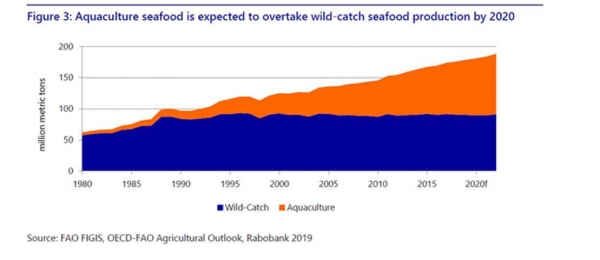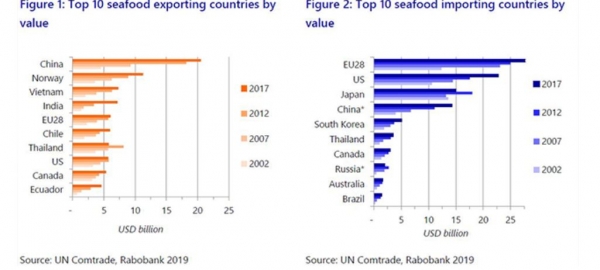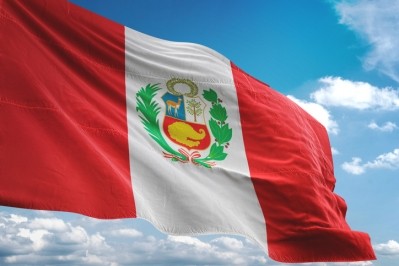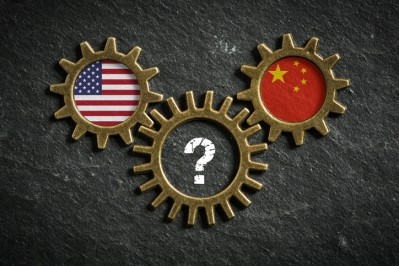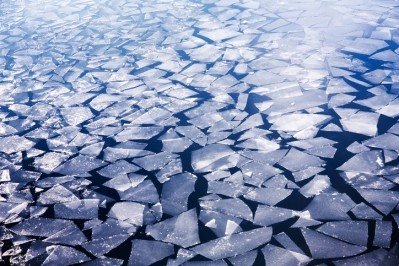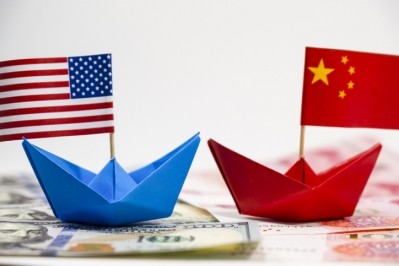Farmed fish volumes to surpass wild catch production by 2020
“We expect future growth in seafood to continue to come from aquaculture, which will be driven by improved genetics, new husbandry technologies, innovations in aquafeed, and the switch to more efficient and intensive farming technologies," reported Rabobank based animal protein analyst, and report author, Beyhan de Jong.
In 2020, the volumes from aquaculture production will surpass the volumes from wild-catch seafood. However, the researcher said the growth of aquaculture is expected to slow down in comparison to the last decade, said the seafood market specialist.
Seafood trade has grown by a CAGR of 4% from 2012 to 2017 to reach an estimated US$153bn, according to the overview. The increase in seafood trade in recent years has been driven primarily by farmed species, consisting of high-value premium crustaceans and marine species and lower-value whitefish species traded from Southeast Asia to western countries.
Rabobank expects this trend to continue.
EU remains largest fish and shellfish importer
The EU is still the largest importer of fish and shellfish, and it increased its imports by US$4bn from 2012 to 2017, concluded the report. The second largest seafood importer, the US, also imported more seafood in the last five years, with an increase amounting to US$5bn. China also significantly increased its seafood imports by more than US$3bn. This value increase in the EU, the US, and China is predominantly driven by increased salmon and crustacean imports, said the analyst.
She expects the EU and the US to remain the leading seafood importers, due to the high demand for seafood in these regions. However, she reckons China could overtake Japan sometime soon: "The current African swine fever (ASF) situation in China's pork production is leading to increased seafood consumption, and there is demand growth for imported and, particularly, premium fish due to increasing purchasing power and food safety concerns over local production in China."
China is still by far the biggest exporter of seafood
Both in volume and value terms, China is still by far the biggest exporter of seafood, followed by Norway, said de Jong. Both countries have added more than US$2bn to their seafood exports between 2012 and 2017. However, there was only a minor increase in the exported volumes, said the analyst.
Vietnam overtook Thailand in seafood exports, reaching the third rank in the top seafood exporters in value, as per the study. The increase in Vietnam’s exports mainly resulted from whitefish and crustacean trade. India also made a big jump from the 8th place to the 4th place, with an increase of US$3.7bn – also driven by increasing shrimp exports, according to the industry note.
“In the upcoming years, we expect China and Norway to keep their positions as the main seafood exporting nations. However, we expect a slower growth rate in Chinese seafood exports.”
Whitefish still has the largest traded volumes, which remain stable despite changes in trade flows. This category consists of farmed and wild-caught species, said Rabobank. A big portion of this trade flow includes China’s re-exports of processed whitefish from Russia.
In comparison to 2013, China’s whitefish exports – mainly tilapia – to the US have dropped by 33%. However, Vietnam filled this gap by increasing its exports to the US, which is dominated by pangasius, said de Jong.
Crustaceans and salmon
From 2013 to 2017, crustacean trade increased globally, with the US, the EU, and China increasing their crustacean imports, said the analyst. India, Indonesia, Vietnam, Mexico, and Ecuador have been the main suppliers due to higher and more efficient production in these regions.
Likewise, salmon trade increased globally due to demand growth. "For example, Chile doubled its salmon exports to China in the last four years. In fact, all salmon producers, and particularly Norway, increased exports to all consumer regions."
Marine ingredients supply
Due to improved supply conditions in Peru, the report noted the fishmeal and fish oil trade has increased in the last four years.
“Driven by its large aquaculture industry, China remains the largest consumer of fishmeal and fish oils, which are supplied mainly by Peru. Relatively higher prices of fishmeal and fish oils have also led to a value increase in trade flows.”
Rabobank is alert to the potential for a slight shift in trading patterns given recent trade wars, and tariff tiffs but also due to a change in the way fish farms might operate in the future.
Increasing protectionism, current uncertainties in trade relations among several trade partners, the growing aquaculture sector in different parts of the world relying on land-based and offshore farms, and biological challenges in the animal protein sector such as ASF could change seafood trade dynamics and routes in the upcoming years, concluded the report.
